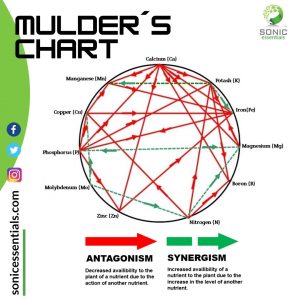It is well known the major elements Nitrogen, Phosphorus, Potassium and Sulphur (NPKS) are essential for plant growth. NPS are all critical to pasture growth in most regions and in many regions, K is also required. The minor elements however, are not to be forgotten. Zinc, Copper and Molybdenum are three very important nutrients in pasture growth along with manganese in some regions. Understanding the way these nutrients work in both the soil and plant is very important. It’s important to also use soil and plant tissue test, in combination with blood tests in stock to make sure the balance is correct for the best outcome.
Zinc
- Zinc is highly immobile in the soil and in the plant.
- Zinc is readily locked up in high pH soils (pH > 8.0).
- Liming can reduce soil available zinc.
- Protein Synthesis and growth regulation require Zinc. Reduced hormone production due to Zinc deficiency will cause the pant to shorten the gap between the internodes and cause stunted leaf growth.
- Zinc aids synthesis of plant growth, it is essential for promoting certain metabolic reactions, which are particularly critical in early growth stage.
- Zinc activates enzymes that are responsible for the synthesis of certain proteins. It is used in the formation of chlorophyll and some carbohydrates, conversion of starches to sugars and its presence in plant tissue helps the plant to withstand cold temperatures. Zinc is essential in the formation of auxins, which help with growth regulation and stem elongation.
- Although it is unusual for zinc to be deficient in permanent pasture in acid soils, it is still beneficial to help through periods of wet, cold conditions.
- Zinc helps to strengthen the root system and the plants defence system
Molybdenum
- Molybdenum is essential for the nitrogen nutrition of plants. This applies particularly to legumes, although molybdenum responses have been also been recorded in cereals and brassicas grown on acid soils.
- Molybdenum is held on clay particles, especially those containing iron and in high organic matter but is mobile in the soil. Molybdenum is the most mobile trace element but requires high rainfall to become mobile.
- Molybdenum deficiency is most likely to occur on acid sands or acid soils containing ironstone.
Copper
- Highly immobile in the soil.
- Copper deficiency is most commonly seen in sandy soils with low organic matter levels, however most copper is bound in complexes in the soil. Copper “tie up” is highest on soils with high organic matter e.g., peats.
- Up to 98% of soil copper can be unavailable.
- Copper has the ability to strengthen the plants lignin and help in the defence of some plant diseases.
- Copper symptom are generally not visible to the eye, but first indications may be low seed production due to its roll in pollination.
- In livestock, high animal intake of iron, molybdenum and/or sulfur can lead to copper deficiency in the animals.
- Plant tissue sampling and stocks blood levels should be monitored for copper and Molybdenum levels.
Boron
- Boron deficiencies are often seen in deep sandy soils in high rainfall zones
- Boron is essentially for plant growth, but only needed in very small amounts
- Boron can also be toxic in soils, often in heavier soils in Mallee regions or in periods of wet followed by dry conditions
- A deficient plant can later in the season have good levels due to the movement of Boron in the soil profile.
Element Interactions
There are so many differing soil types in Australia, there is not one set of nutrition rules to fit all these soil types. Knowing your soils is key to success, this is best achieved by soil testing and plant tissue testing, however it’s not as simple as applying more of one element and having the problem solved. All elements in the soil and plant interact, some antagonistically and some synergistic. The following are the main interactions that you need to be aware of
- Excess lime spreading can induce all trace element deficiencies
- Excess P adversely affects the Zinc (Zn), Copper (Cu) and Iron (Fe) utilization
- Excess Zinc, Manganese and copper induces Iron deficiency but excess Iron can affect the utilization of Zinc and Manganese
- Excess Sulfur and Copper can induce molybdenum deficiency
- Excess Calcium can cause Phosphorus tie up leading to deficiency
- Excess Magnesium and Calcium may depress Potassium uptake
- Excess Nitrogen, potassium and calcium could reduce boron toxicity
- Excess Nitrate N may cause Iron Deficiency
- Excess Nitrogen can cause copper deficiency
Mulder’s chart was introduced to give a visual for the nutrient’s interaction

Rates
Rates for pastures will vary from area to area and sometimes even paddock to paddock. It’s important to take the above into consideration when applying. Always remembering the critical elements for a successful pasture, the rates below are the range we suggest to apply our products, it is good to get these out at the start of growth ensuring there is enough foliage to take the product in. After grazing of the pasture, it would be beneficial to re-treat once growth has come back to allow the foliage to again take the trace element in. Remembering to soil test, plant tissue test and also take some blood from the grazing stock to keep check on the nutrient balance.
IcON Zinc 100-200ml/ha
IcON Copper 50-100ml/ha
IcON Plus 100-300ml/ha
Nutri Essentials Boron 1-2L/ha
A typical application in pastures, including grass, legume and brassica pastures is 200mL/Ha of IcON Plus with 100mL/Ha of IcON zinc. Pending local conditions, we have found that this blend has proven its self in a lot of Australian regions. For maximum pasture growth it is essential to keep the nutrition balanced and to achieve this testing of both soil and plants is essential.
